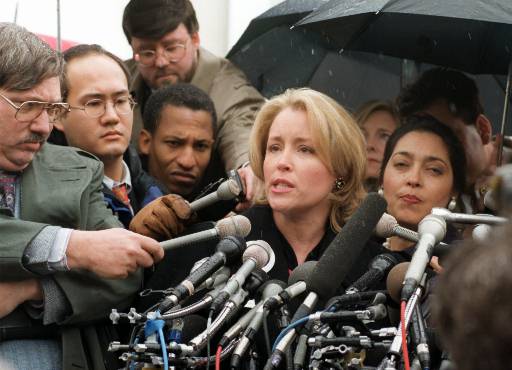

In this photo, Donna Rice Hughes, of the anti-pornography organization Enough is Enough, meets reporters outside the Supreme Court in 1997 after the court heard a First Amendment facial challenge to 1996 Communications Decency Act. A facial challenge contends that a government law, rule, regulation, or policy is unconstitutional as written — that is, on its face. (AP Photo/Susan Walsh, used with permission from the Associated Press)
A facial challenge contends that a government law, rule, regulation, or policy is unconstitutional as written — that is, on its face. This challenge differs from an as-applied challenge in that it invalidates a law for everyone — not just as that law is applied to the particular litigant challenging it.
A facial challenge often asserts that a law is either unconstitutionally overbroad or unconstitutionally vague. A First Amendment facial challenge asserting overbreadth contends that the law sweeps too far and prohibits expression that should be protected, in addition to expression that can be proscribed. A First Amendment–based facial challenge asserting vagueness contends that the law fails to define key terms so that individuals do not know whether certain expression will constitute a violation of the law.
Classic examples of laws suffering from facial overbreadth and vagueness are the provisions of the Communications Decency Act of 1996 that criminalized the online transmission of “patently offensive” and “indecent” speech on the Internet. In Reno v. American Civil Liberties Union (1997), the Supreme Court struck the provisions down on their face.
The Roberts Court struck down a federal law prohibiting images of animal cruelty in United States v. Stevens (2010), finding that the law was facially unconstitutional. The Court reasoned the law was written so broadly that it could apply to some hunting videos.
In recent years, if the Court has struck down a law on First Amendment grounds, it has accepted the argument that the law is facially unconstitutional.
If the Court has rejected a facial challenge, it often has asserted that litigants can prevail only by showing, in an as-applied challenge, that their speech was discriminated against.
According to legal scholar David H. Gans (2005), “many of the most hotly contested constitutional questions turn on the choice between sustaining a facial challenge or requiring affected parties to bring a series of as-applied challenges” (p. 1334).
Some commentators have called for a fresh look at the notion of classifying a challenge as as-applied or facial. Harvard Law School professor Richard H. Fallon Jr. (2000) has concluded that “there is no single distinctive category of facial, as opposed to as-applied, litigation. Rather, all challenges to statutes arise when a particular litigant claims that a statute cannot be enforced against her” (p. 1324).
David L. Hudson, Jr . is a law professor at Belmont who publishes widely on First Amendment topics. He is the author of a 12-lecture audio course on the First Amendment entitled Freedom of Speech: Understanding the First Amendment (Now You Know Media, 2018). He also is the author of many First Amendment books, including The First Amendment: Freedom of Speech (Thomson Reuters, 2012) and Freedom of Speech: Documents Decoded (ABC-CLIO, 2017). This article was originally published in 2009.